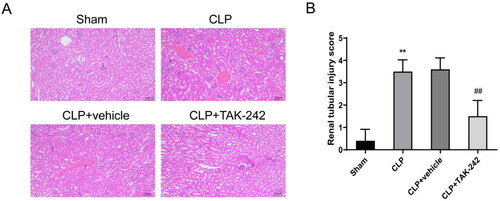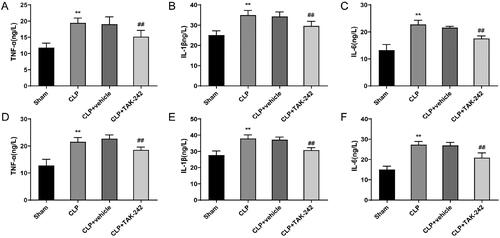Figures & data
Figure 1. TAK-242 Relieves sepsis-induced kidney injury. (A–C) Detection of BUN (A), Cr (B), and Cys-C (C) levels in serum of rats in the Sham group, CLP group, CLP + vehicle group, and CLP + TAK-242 group. **p < 0.01, vs. Sham group; ##p < 0.01, vs. CLP + vehicle group. BUN: blood urea nitrogen; Cr: creatinine; Cys-C: cystatin-C.

Figure 2. TAK-242 attenuates pathological damage of kidney tissues in septic rats. (A) H&E staining to observe the pathological changes in the kidney tissues of rats in Sham group, CLP group, CLP + vehicle group, and CLP + TAK-242 group; (B) kidney tissue damage scores of rats in each group based on the results of . **p < 0.01, vs. Sham group; ##p < 0.01, vs. CLP + vehicle group.

Figure 3. TAK-242 reduces the level of oxidative stress in kidney of septic rats. (A–C) Detection of ROS (A), MDA (B),SOD (C) levels in kidney tissues of rats in the Sham group, CLP group, CLP + vehicle group, and CLP + TAK-242 group. **p < 0.01, vs. Sham group; ##p < 0.01, vs. CLP + vehicle group. ROS: reactive oxygen species; MDA: malondialdehyde; SOD: superoxide dismutase.

Figure 4. TAK-242 improves mitochondrial function in kidney tissues of septic rats. (A–C) Detection of mitochondrial membrane potential (JC-1, A), ATP content (B) and MPO activity (C) in kidney tissues of rats in the Sham group, CLP group, CLP + vehicle group, and CLP + TAK-242 group. **p < 0.01, vs. Sham group; ##p < 0.01, vs. CLP + vehicle group. ATP: adenosine triphosphate; MPO: myeloperoxidase.

Figure 5. TAK-242 reduces inflammation levels in septic rats. (A–F) ELISA to measure the levels of TNF-α, IL-1β, and IL-6 in the serum (A–C) and kidney tissues (D–F) of rats in the Sham group, CLP group, CLP + vehicle group, and CLP + TAK-242 group. **p < 0.01, vs. Sham group; ##p < 0.01, vs. CLP + vehicle group. TNF-α: tumor necrosis factor alpha; IL: interleukin.

Figure 6. TAK-242 inhibits activation of the TLR4/NF-κB signaling pathway in kidney tissues of septic rats. (A) Western blot to check the protein levels of TLR4, MyD88, p65, p-p65 in kidney tissues of rats in the Sham group, CLP group, CLP + vehicle group, CLP + TAK-242 group; (B) the protein expression levels of TLR4 and MyD88 and the ratio of p-p65/p65 in the tissues of each group analyzed based on the results of . **p < 0.01, vs. Sham group; ##p < 0.01, vs. CLP + vehicle group. TLR4: toll-like receptor 4.

Supplemental Material
Download PDF (107.7 KB)Data availability statement
The datasets generated and or analyzed during the current study are available from the corresponding author on reasonable request.
